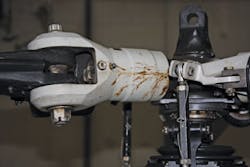Chris Cooper says, “After two years of early retirement I knew it wasn’t for me, so I decided to get back to my aviation roots by opening a helicopter flight school.” He began by consulting with operators of small reciprocating engine helicopters around the country and ultimately chose to use the Schweizer as his primary trainer.
Since opening Hummingbird Helicopters of Minnesota in 2002, his company has operated as many as five helicopters and gained approximately 12,500 flight hours of experience in the Schweizer 300s and Robinson R-22 and R-44 helicopters. Cooper uses these small helicopters primarily for flight training, air rides, photo flights, deer survey, and just about any other use he can find for them.
Cooper says, “I’m a Vietnam era helicopter maintenance test pilot and even though I do not have an A&P certificate, I’ve always maintained a close involvement with aircraft maintenance. I’ve learned the importance of paying very close attention to detail when maintaining a helicopter.” He goes on to share a few lessons learned relating to maintaining the Schweizer 300CB helicopter.
Lubrication
Bill Halpin, director of maintenance for Hummingbird Helicopters, shares, “Grease is cheap and helicopter components are expensive. As you know not all grease is the same, so don’t make assumptions about lubricating using the same type of grease.”
Cooper and Halpin went on to discuss some of the lubrication practices that have been implemented for their Schweizer 300CB. The first stop was the lubrication chart in the Handbook of Maintenance Instructions (HMI) for the 300CB. It’s easy to see that numerous types of lubricants are required and that many areas of the helicopter have different lubrication intervals. Cooper provides the example of the belt drive assembly on the 300CB which consists of a lower drive pulley, an upper drive pulley, and an idler pulley all having different lubricating requirements.
Halpin explains that it’s important to understand the basic concept of purge lubrication; which means to pump new grease into a grease fitting or grease nipple (commonly referred to as a Zerk fitting after the inventor Oscar Zerk in 1929) until all the old grease has been visibly displaced. The HMI requires certain points on the 300CB be greased every 25 flight hours of operation.
Cooper says, “We’ve learned that lubricating certain areas at 10 flight hour intervals is a much better practice for our type of operation. As an example the three main rotor pitch bearings, the flapping hinge bearings, the upper and lower swash plate scissors links, the main rotor droop stop, and the main rotor swash plate bearing sleeve all get purge lubricated at every 10 flight hours on our Schweizer.”
They also caution helicopter maintainers to be mindful of the operating environment. There may be multiple types of grease approved for one application. Make sure you use the best type of grease for the climate you operate in.
An example of this is the Anderol 786 grease which the HMI states is used when the temperatures are 17.8 C or 0 F and above. Cooper shares, “Here in the cold climates we routinely operate in temperatures below 0 F. We’ve learned that an approved alternative Syn-Tec 3913G1 holds up better in these cold weather operations.”
Another tip regarding operating environments is to always purge lubrication after operating the helicopter in the rain, or in dusty or dirty conditions. The HMI for the 300CB speaks to lubricating the rotor head bearings after operating in the rain.
Purge lubrication also requires a detailed cleaning when completed. You need to remove the excess grease that was displaced during the lubrication task. The rotating areas of the helicopter will sling a certain amount of grease, so removing all excess after the purge will provide a cleaner area.
Halpin says, “Excess grease that slings out of fittings appears nasty, and when operating rentals and training helicopters appearance counts.” He goes on to explain a caution regarding the cleaning of excess grease after purge lubrication. “Be careful to not use excess force when cleaning excess grease from bearing retainers, rubber boots, and protective covers,” he says. “In some cases I like to use an acid brush just so I don’t apply excessive or uneven pressure around certain retainers.”
He went on to explain how a local helicopter owner/pilot learned an expensive lesson regarding cleaning excess grease from areas of the rotor head on his personal helicopter. While wiping excess grease from the area he unknowingly snagged a cotter pin with his cleaning rag and opened the legs of the cotter pin. The pin stayed in place; however, it now contacted the upper portion of the swash plate and eventually scored the component requiring a very costly replacement. Again, pay attention to detail.
Vibration, balance, and blades
Cooper says, “Vibration management is another issue that helicopter maintainers need to be very mindful of. Beginning at the tail of the helicopter, the tail rotor provides a lot of stress at the end of a long arm — the tailboom. We pay particular attention to the entire tail rotor area and tailboom for any unusual wear, cracking, or other signs that vibration is beginning to create a problem.”
Vibration resulting from both the tail rotor and main rotor blades can be linked to many mechanical failures from simple burnt-out light bulbs to fatigue cracks in the structure and the engine cooling baffles.
Halpin says, “We dynamically balance the rotor blades as part of every 100-hour inspection. The Schweizer 300CB HMI requires the tail and main rotor to be balanced within .2 inches per second (ips). With the modern equipment available today you can easily do a much better job of balancing the rotor blades. We regularly are able to balance within .02 ips which we feel is much better on the helicopter.”
Careful balancing of the internal components of an engine during overhaul is an important feature that can help with overall vibration management. The Lycoming engine in the 300CB operates constantly at a power setting of 2,600 rpm and dynamic balance under operating conditions enhances overall comfort.
Another vibration-related aspect is the ground resonance dampening system on the 300CB. It was explained that the dampening system for the fully articulating rotor system on this helicopter consists of three lead-lag dampeners, one associated with each main rotor blade, and four landing gear dampeners, one on the fore and aft points of the right and left skids. Together they make up the entire ground resonance dampening system which is necessary to dampen out possible vibration induced when landing. The main rotor blade lead-lag dampeners contain a series of potted-rubber “donuts.” The landing gear dampeners are a cylinder containing oil and charged with 700 psi of nitrogen.
Halpin explains, “The landing gear dampeners have a tight tolerance and should have no visible signs of weeping. We have special fixtures and tooling for overhauling the landing gear dampeners and provide this service to other Schweizer operators.”
Then there’s blade erosion, another area to pay particular attention to. Cooper says, “Each of the three main rotor blades costs approximately $18,000. Flying in the rain, sand, and dust can rapidly erode the leading edges.”
Cooper shares this final comment to other operators, “Regular inspection and preventative maintenance based on your specific type of operation is a key element in controlling maintenance and operating costs at a small operation like ours.”
For more information relating to the Schweizer 300 helicopter visit www.sacusa.com, or Hummingbird Helicopters of Minnesota at www.hummingbirdhelicopters.us.





